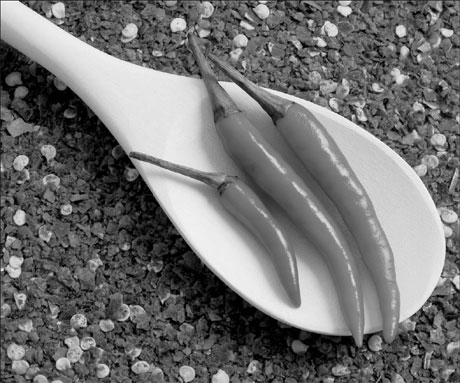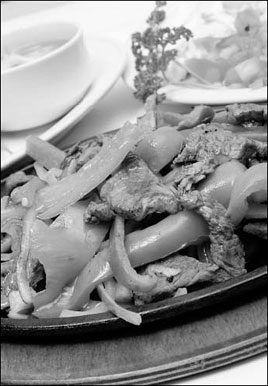Life and Leisure
Breathing fire
By James Gorman (The New York Times)
Updated: 2010-10-04 07:39
 |
Large Medium Small |
|
Some experts argue humans like chilies because of their health benefits. Other believe the pain is pure pleasure. Tuweimei |
Foodies find pleasure in the pain of chili peppers, James Gorman reports
Late summer is chili harvest time, when the entire state of New Mexico savors the perfume of roasting chilies, and across the country the delightful, painful fruit of plants of the genus Capsicum are being turned into salsa, hot sauce and grizzly-bear repellant.
Festivals abound, often featuring chili pepper-eating contests. "It's fun," as one chili pepper expert wrote, "sorta like a night out to watch someone being burned at the stake."
In my kitchen, as I turn my homegrown habaneros into hot sauce while wearing a respirator (I'm not kidding) I have my own small celebration of the evolutionary serendipity that has allowed pain-loving humans to enjoy such tasty pain.
Some experts argue that we like chilies because they are good for us. They can help lower blood pressure, may have some anti-microbial effects, and they increase salivation, which is good if you eat a boring diet based on one bland staple crop like corn or rice. The pain of chilies can even kill other pain, a concept supported by recent research.
|
Fried beef with chili peppers is a popular dish in China. Tuweimei |
Others, notably Dr Paul Rozin at the University of Pennsylvania, argue that the beneficial effects are too small to explain the great human love of chili-spiced food. "I don't think they have anything to with why people eat and like it," he says in an interview. Rozin, who studies other human emotions and likes and dislikes thinks that we're in it for the pain. "This is a theory," he emphasizes. "I don't know that this is true."
But he has evidence for what he calls benign masochism. For example, he tested chili eaters by gradually increasing the pain, or, as the pros call it, the pungency, of the food right up to the point at which the subjects said they just could not go further. When asked after the test what level of heat they liked the best, they chose the highest level they could stand, "just below the level of unbearable pain". As Delbert McClinton sings, (about a different line of research), "It felt so good to hurt so bad."
I have to agree, although by true chili head standards, I am a wimp. I can tolerate only a moderate degree of pain, perhaps because I came to chilies late in life. My son was quite impressed with an in-law who grew up in Mexico and ate habanero peppers whole, so my wife suggested a father-son gardening project. The first year only one plant survived the woodchucks and deer. But what a plant - it produced a bumper crop of killer orange habaneros. Nothing ate them. In my mind I still see that plant dangling its little orange heat grenades in front of the deer and growling, "Bite me, Bambi."
Habaneros are very hot, although there's a lot of variation. On the standard Scoville heat scale (Bell peppers - 0; the hottest Indian jolokia peppers - 1,000,000) orange habaneros run 100,000 to 350,000. By comparison, jalapenos can go anywhere from 5,000 to 50,000. Two percent capsaicin bear spray is advertised at 3.3 million units, and pure capsaicin - the chemical that causes the pain - hits 16,000,000.
This is the kind of plant that endears itself to a teenage boy. These weren't vegetables, they were weapons! And it was legal to grow them. We started planning next year's garden at once.
The garden grew, year by year, and led to the bottling of hot sauce, and then, to my first hesitant steps into the capsaicin demi-monde. I met some pain junkies at work. I bought the T-shirt with the capsaicin molecule on it. I marveled at the uncountable number of artisanal hot sauces on the market, and at the frequency with which the words death, nuclear and devil were used in the names. I have to say that I drew the line at getting a capsaicin molecule tattoo. And I did not buy the T-shirt with the flaming red mouth and the legend, Pain is Good.
This chest beating may be particular to the United States, where one hot sauce maker actually markets a limited edition of pure capsaicin. In places like Central America, Asia and the Indian subcontinent, hot chili peppers are an integral part of the cuisine. Only the commercial genius of American marketing could come up with a product that is marketed on the basis that you won't be able to use it.
End of Life Hot Sauce! So Painful You Will Die! Visa, Mastercard, Discover or Paypal accepted. Well darn, sign me up for that.
How did this happen? The story of how chilies got their heat is pretty straightforward. A recent study suggested that capsaicin is an effective defense against a fungus that attacks chili seeds. In fact, experiments have shown that the same species of wild chili plant produces a lot of capsaicin in an environment where the fungus is likely to grow, and very little in drier areas where the fungus is not a danger.
The fact that capsaicin causes pain to mammals seems to be accidental. There's no evolutionary percentage in preventing animals from eating the peppers, which fall off the plant when ripe. Birds, which also eat fruits, don't have the same biochemical pain pathway, so they don't suffer at all from capsaicin. But in mammals it stimulates the very same pain receptors that respond to actual heat. Chili pungency is not technically a taste, it is the sensation of burning, mediated by the same mechanism that would let you know that someone had set your tongue on fire.
But humans took to them quickly. There is evidence that by 6,000 years ago domesticated Capsicums (hot peppers) were being used from the Bahamas to the Andes. Once Columbus brought them back from the New World chilies spread through Europe, Asia and Africa. Jean Andrews, in the classic, Peppers: The Domesticated Capsicums, (in which she made the comment above about pepper competitions and being burned at the stake), tracks the spread of peppers from the new world by early writers. By the mid-1500, they were known in Europe, Africa, India and China.
No one knows for sure why humans would find pleasure in pain, but Rozin suggests that there's a thrill, similar to the fun of riding a roller coaster. "Humans and only humans get to enjoy events that are innately negative, that produce emotions or feelings that we are programmed to avoid when we come to realize that they are actually not threats. Mind over body. My body thinks I'm in trouble but I know I'm not." And it says, hand me another jalapeno.
Other mammals have not joined the party. "There is not a single animal that likes hot pepper," Rozin says. Or as Paul Bloom, a Yale psychologist, puts it, "Philosophers have often looked for the defining feature of humans - language, rationality, culture, and so on. I'd stick with this: Man is the only animal that likes Tabasco sauce."
That's from Bloom's new book, How Pleasure Works: The New Science of Why We Like What We Like, in which he addresses the general nature of human pleasure, and some very specific, complicated pleasures. Some, like eating painfully spicy food, are accidental, at least in their specificity. A complicated mind is adaptive but love of chilies is an accident.
And that is what I celebrate behind my respirator as my son and I dice habaneros, accidental pleasures. A taste for chilies has no deep meaning, no evolutionary value. It's just a taste for chilies. I might add though, that since it takes such a complicated brain and weird self-awareness to enjoy something that is inherently not enjoyable, only the animal with the biggest brain and the most intricate mind can do it.
Take heart, chili heads. It's not dumb to eat the fire, it's a sign of high intelligence.
James Gorman reports for The New York Times.

